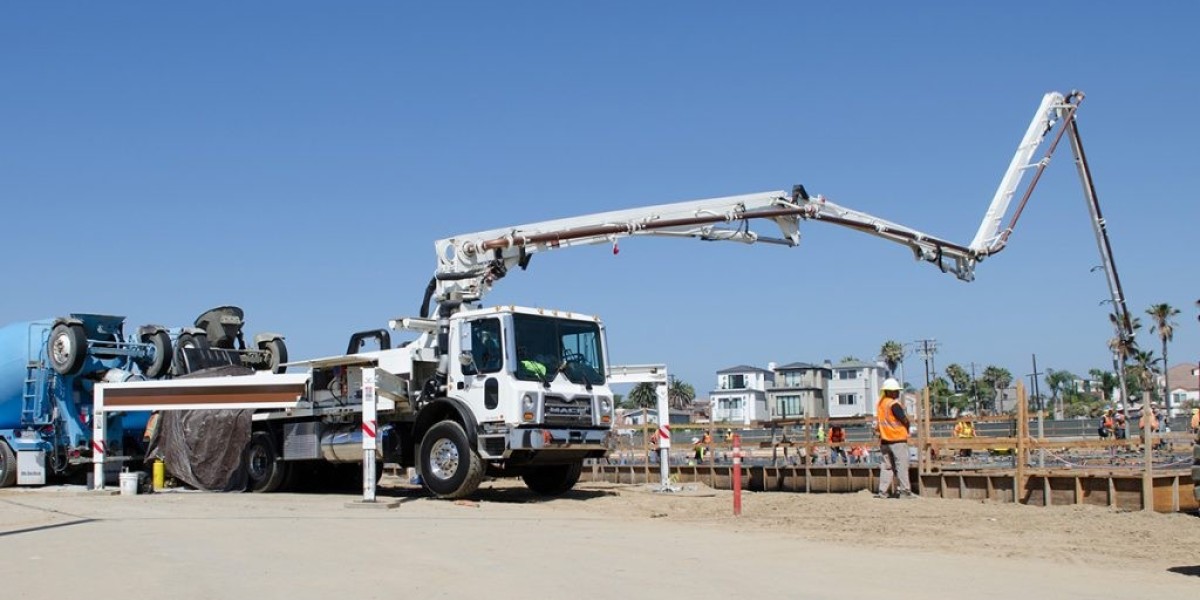Concrete pumping is transforming how construction projects are executed, allowing contractors to complete large-scale and complex builds with greater speed and efficiency. Whether you're working on a high-rise building, residential property, or infrastructure project, the right concrete pumping method can save time, reduce labor costs, and ensure a higher-quality result.
In this guide, we’ll delve into the ins and outs of concrete pumping, explore its benefits, and provide tips for achieving maximum efficiency in your construction projects.
1. Understanding Concrete Pumping: What Is It?
Concrete pumping is the process of transporting and placing concrete from a mixer truck to the construction site using a pump. This technique allows the concrete to be poured directly where it’s needed, even in areas that are difficult to reach using traditional methods.
Types of Concrete Pumps:
- Boom Pumps: These pumps are mounted on a truck with a long robotic arm (or boom) that can reach over obstacles to place concrete at heights or long distances.
- Line Pumps: These pumps use flexible or rigid hoses to transport concrete horizontally or at lower heights. They are ideal for smaller projects or sites with limited access.
2. Benefits of Using Concrete Pumping
Concrete pumping offers several advantages over conventional methods, making it a go-to solution for modern construction projects.
Key benefits include:
- Increased Efficiency: Pumping concrete directly to the desired location reduces the need for manual labor, accelerates the process, and minimizes delays.
- Precision Placement: Whether it’s high-rise construction or foundation work, concrete pumps allow for precise placement, ensuring even distribution and reducing the likelihood of waste.
- Reach Difficult Areas: Boom pumps can deliver concrete to hard-to-reach areas like upper floors or tight spaces, eliminating the need for cranes or wheelbarrows.
- Reduced Labor Costs: With less manual work required to transport and place the concrete, you can significantly cut down on labor expenses.
- Improved Quality: Concrete that is pumped experiences less handling, reducing the risk of contamination and ensuring a consistent mix throughout the structure.
3. Choosing the Right Concrete Pumping Method
Selecting the right concrete pumping method for your project depends on several factors, including the size and complexity of the project, the type of structure being built, and site accessibility.
Factors to consider when choosing a pump:
- Project Size: For large-scale projects, a boom pump may be necessary to cover the extended reach and volume requirements. Smaller residential or commercial projects might be well-served by a line pump.
- Site Conditions: Assess whether the site is easily accessible or if there are obstacles that require the long reach of a boom arm.
- Height and Distance: Consider the height and distance the concrete needs to be transported. Boom pumps are ideal for high-rise structures, while line pumps work well for horizontal or low-rise projects.
4. Planning for Efficient Concrete Pumping
Proper planning is key to ensuring that your concrete pumping process runs smoothly and efficiently. By preparing the site and coordinating logistics in advance, you can minimize delays and avoid potential issues.
Steps for effective planning:
- Prepare the Site: Clear the site of any obstacles and ensure that the pump has sufficient space for setup. The area around the pour site should also be accessible to the hose or boom arm.
- Coordinate with the Supplier: Ensure your concrete supplier understands the specific needs of the project, such as the mix type, volume, and timing of delivery. Concrete must be ready at the exact time the pump is in place.
- Test the Equipment: Before starting, conduct a test run of the pump to ensure it’s functioning correctly and that there are no blockages or mechanical issues.
- Ensure a Continuous Flow: To prevent delays, ensure that concrete is continuously flowing through the pump, and have backup trucks on standby if needed.
5. Best Practices for Concrete Pumping Efficiency
Maximizing efficiency during concrete pumping can lead to faster project completion, better-quality pours, and reduced costs. Follow these best practices to achieve optimal results.
1. Use the Right Mix:
The concrete mix should be pumpable, meaning it has the right consistency and doesn’t segregate during pumping. Ensure that your supplier provides a mix that meets the specifications for the type of pump you’re using.
2. Maintain Equipment Regularly:
Routine maintenance of pumps and hoses is crucial for minimizing downtime and preventing breakdowns during crucial pours. Keep spare parts on hand and check hoses for leaks or wear.
3. Employ Experienced Operators:
An experienced pump operator can greatly improve the efficiency of the concrete pumping process. They will know how to handle the equipment, troubleshoot issues, and ensure safe and precise delivery.
4. Minimize Delays Between Batches:
Keeping a continuous flow of concrete ensures that there are no interruptions in the pumping process, which can lead to inconsistent pours or hardened concrete in the lines.
5. Monitor Weather Conditions:
Extreme weather conditions, such as high heat or freezing temperatures, can affect the quality of the concrete and the pumping process. Monitor the weather and adjust the timing of your pour accordingly.
6. Safety Considerations During Concrete Pumping
Safety should always be a top priority on any construction site, especially during concrete pumping, which involves heavy machinery, high pressure, and the handling of potentially hazardous materials.
Essential safety practices:
- Wear Protective Gear: Ensure all workers wear proper personal protective equipment (PPE), including hard hats, safety glasses, gloves, and boots.
- Monitor Pressure Levels: Concrete pumps operate under high pressure, and any blockages in the hoses can lead to dangerous blowouts. Monitor pressure gauges carefully to prevent accidents.
- Secure the Boom: For boom pumps, make sure the boom arm is properly secured and balanced to avoid tipping or collapse.
- Clear Communication: Maintain clear communication between the pump operator, the concrete delivery team, and the construction crew to avoid accidents or missteps during the pour.
- Have an Emergency Plan: Always have a contingency plan in place in case of equipment failure or other emergencies.
7. Innovations in Concrete Pumping Technology
The construction industry is always evolving, and concrete pumping technology has seen significant advancements in recent years. These innovations aim to improve efficiency, reduce labor, and enhance the quality of concrete placement.
Key innovations include:
- Remote-Controlled Boom Pumps: Newer models allow operators to control the boom arm remotely, providing better precision and reducing the risk of human error.
- Self-Cleaning Pumps: Modern concrete pumps come equipped with self-cleaning mechanisms, which reduce the downtime needed for maintenance and cleaning after each use.
- High-Pressure Pumps: High-pressure concrete pumps allow for faster pours over longer distances, making them ideal for large infrastructure projects like bridges and skyscrapers.
8. Cost Considerations for Concrete Pumping
Concrete pumping can offer significant savings by reducing labor and speeding up project timelines, but it’s important to account for all associated costs when planning your budget.
Factors that affect the cost of concrete pumping:
- Type of Pump: Boom pumps tend to be more expensive than line pumps due to their size and reach capabilities.
- Distance and Height: The further and higher the concrete needs to be pumped, the more powerful and costly the pump required.
- Project Duration: The longer you need the pump on-site, the higher the rental or operational costs. Efficient planning and execution can help reduce rental time.
- Concrete Mix: Specialty mixes designed for pumping may cost more than standard concrete, but they can prevent costly issues like blockages or poor-quality pours.
Conclusion
Concrete pumping is a game-changer in modern construction, offering unparalleled efficiency, precision, and safety. By choosing the right pump for your project, planning carefully, and following best practices, you can ensure a successful pour that meets both time and budget constraints.
Whether you’re working on a small residential project or a large-scale commercial build, investing in concrete pumping technology will lead to faster completion times, reduced labor costs, and better overall results.








